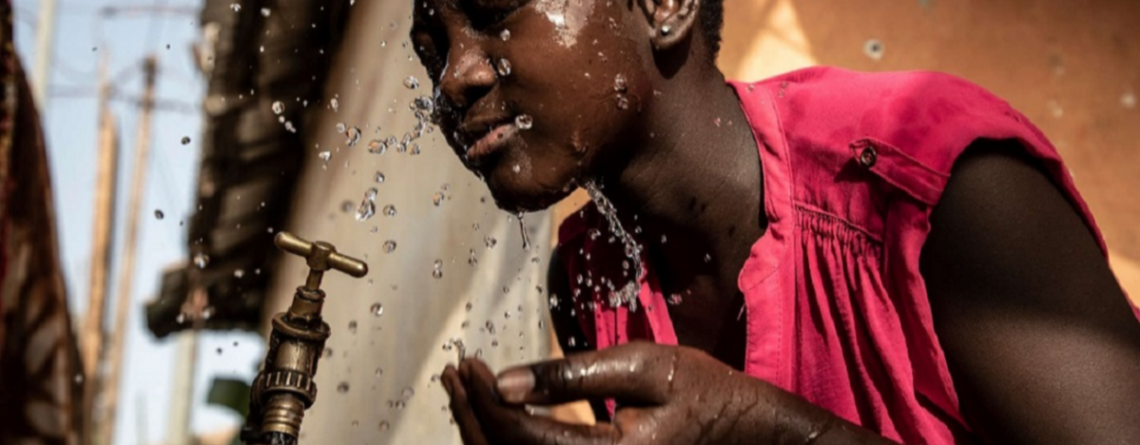The Gambia’s Water Paradox: How A Country With Plentiful Water Resources Is Failing To Provide Safe Water To Its People
Bintou Kijera was exhausted. Neither she nor her three-year-old daughter had slept the previous night: the little girl was simply too sick.
The two were at The Gambia’s second biggest hospital, Serekunda General Hospital, where the toddler had been diagnosed with diarrhoea.
“I have changed her diapers more than four times,” the young woman said, pointing at the pale and malnourished looking girl mounted on her back.
Neither Kijera nor the nurse who diagnosed the condition of her daughter could say for certain what caused her diarrhoea.
“I don’t actually know whether it is caused by the food she ate or the water she drank. She just started to pass frequent watery stool the day before yesterday, and it became worse last night,” Kijera said.
This lack of detail and information about the girl’s illness is a common problem. Hardly any of The Gambia’s public health centres have the facilities to examine and identify what strain of bacteria is causing diarrhoea in their patients.
Kijera’s suggestion that water may have made her daughter ill is likely accurate: a data-driven investigation has uncovered shocking details of the dangers of water consumed by people in mainland Africa’s smallest country.
It shows how a series of spiralling events in the poor treatment, delivery and handling of water badly compromises the quality of The Gambia’s water. This includes both piped water and water from open wells, drawn from the country’s underground
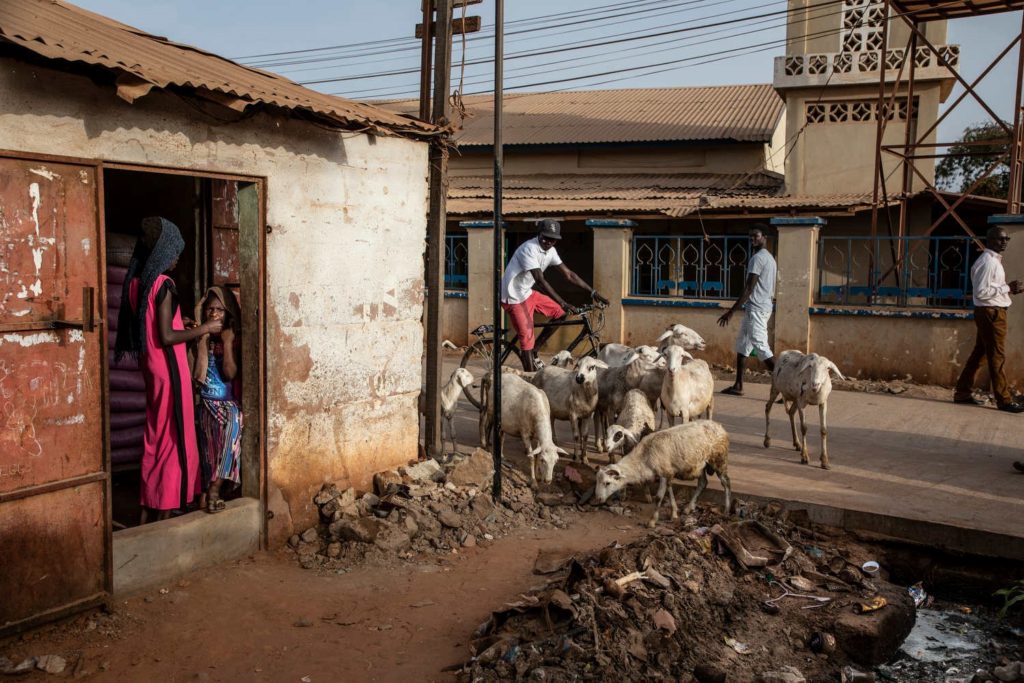
The devil’s in the details
The most recent Multiple Indicator Cluster Survey (MICS) report, released in July 2019, found that 73.2% of the country’s 2.2 million population had E. coli in household drinking water. MICS is a multi-purpose household survey conducted by The Gambia Bureau of Statistics, with technical support from the United Nations Children’s Fund (UNICEF). It takes water samples from both pipe-bourne water sources and open wells across the country. The survey found that remnants and by-products of faeces from humans and some animals are the main sources of E. coli in household water.

Further data reveals that more than 45.3% of the population is relying on contaminated water sources, including water supplied by the National Water and Electricity Company (NAWEC), a public company which is the country’s sole source of pipe-bourne water.
Symptoms of E. coli infection can include abdominal cramp, diarrhoea, urinary tract infections and pneumonia. In a small proportion of patients — particularly young children and the elderly — it may lead to death or to life-threatening diseases.
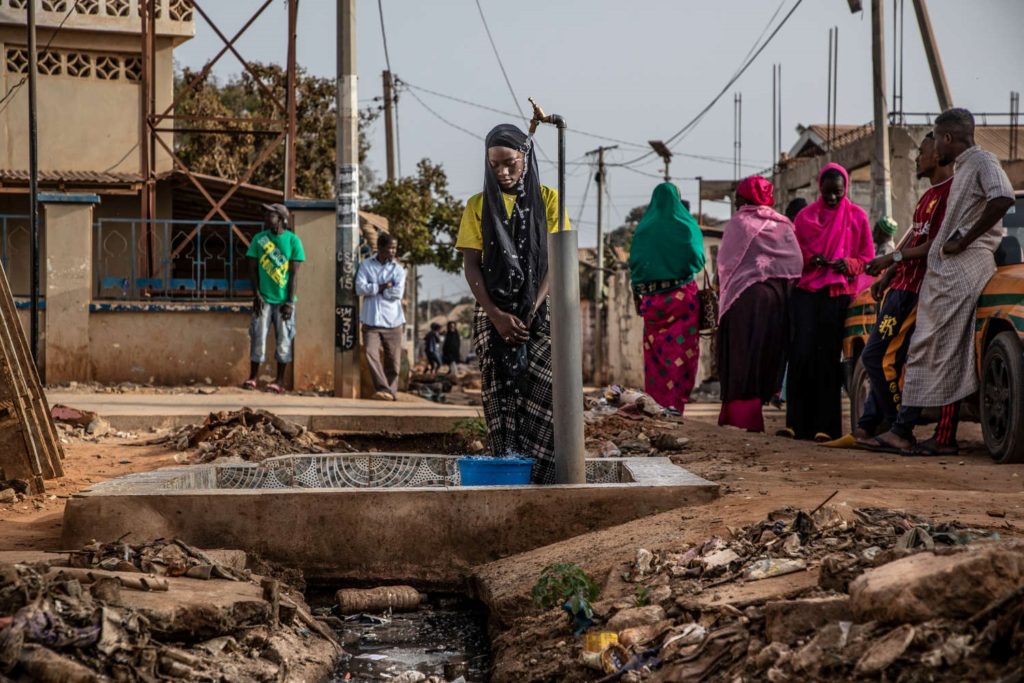
Cascading problem
Our investigation revealed the cascading nature of The Gambia’s water problems. Though The Gambia’s water, sewage and electricity assets are owned by the government, they are managed and operated by NAWEC.
Coli contamination occurs as the water is piped through NAWEC’s deteriorating infrastructure; burst pipes are a common issue. Worse yet, when the water reaches the people who will use it for drinking, bathing and cooking, it becomes yet more contaminated because it’s simply not handled properly (for instance, people defecate and don’t wash their hands with soap before using the water for cooking and consumption).

On paper, the country shouldn’t have any water problems. The Gambia has adequate water resources to supply its population of 2.45 million people. The small West African nation has plentiful surface water in the Gambia River – after which the country is named – and yet the river is rarely used for potable water supply.
The country’s highest water demand is in large population centres and tourism areas, mainly in the coastal areas, where the river has high salinity. Many studies have reported a range of health problems — from hypertension to skin diseases, acute respiratory infections and diarrheal diseases — due to increased salinity exposure through drinking, cooking and bathing.
As such, highly seasonal rainfall and a lack of smaller perennial rivers mean that all potable water demand, in rural and urban areas alike, is largely met by groundwater supplied by NAWEC and private wells.
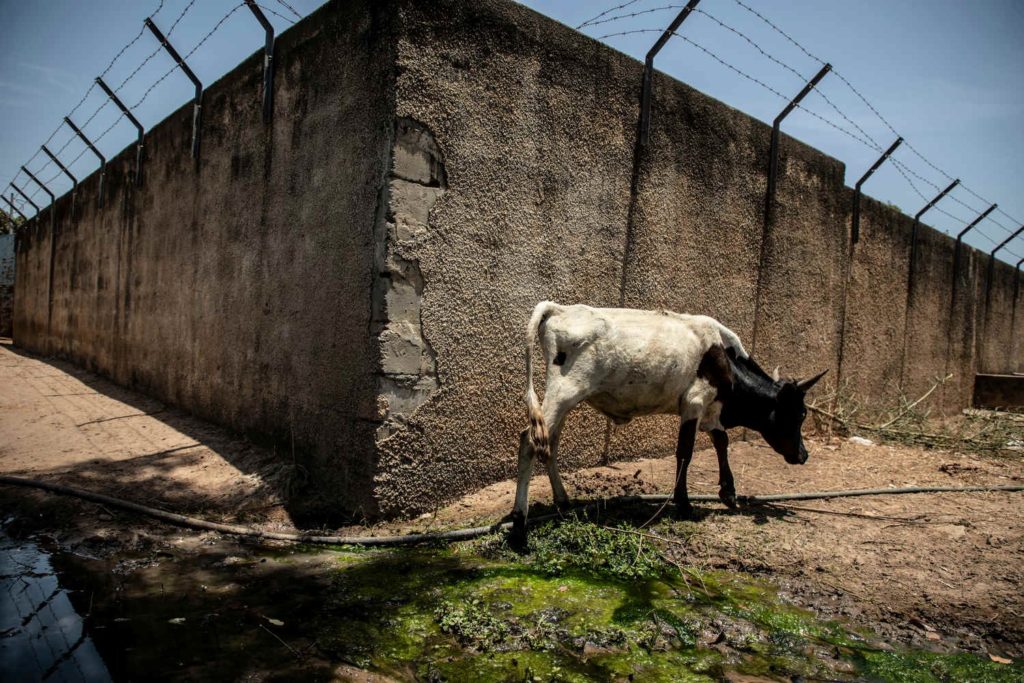
Lack of maintenance
Site visits in mid-2020 by The Gambia’s Public Utilities Regulatory Authority (PURA) also revealed a host of serious problems at NAWEC’s Farafenni, Bansang, Mansakonko and Soma water treatment plants. Apart from a lack of maintenance on equipment and buildings, it also found “animal intrusion” and “poor sanitary conditions” in treatment areas; failure to properly chlorinate water; leaking tanks and “delivery of water with high iron levels” that “fails to meet the minimum standard”.
Fines totalling 3.5 million dalasis (almost $70,000) were levied against NAWEC, with a provision for further fines until the identified problems were resolved.
Comments on the PURA Facebook post detailing what it had found showed that the issues go far beyond just four treatment plants.
“Sanchaba Sulay Jobe, close to Kerr Serigne, is always without water during [the] daytime,” wrote Astou Jobe, a Gambian native, in response to the PURA post. “The only time the water comes to that area is around 6am for about one hour, and that is not every day. At times the area is without water for days.”
Fatou Saine, another Gambian, commented: “People are suffering. Without water they cannot do much. Even Salagie, Wullinkama and other areas close to the city [Banjul] do not have water”.
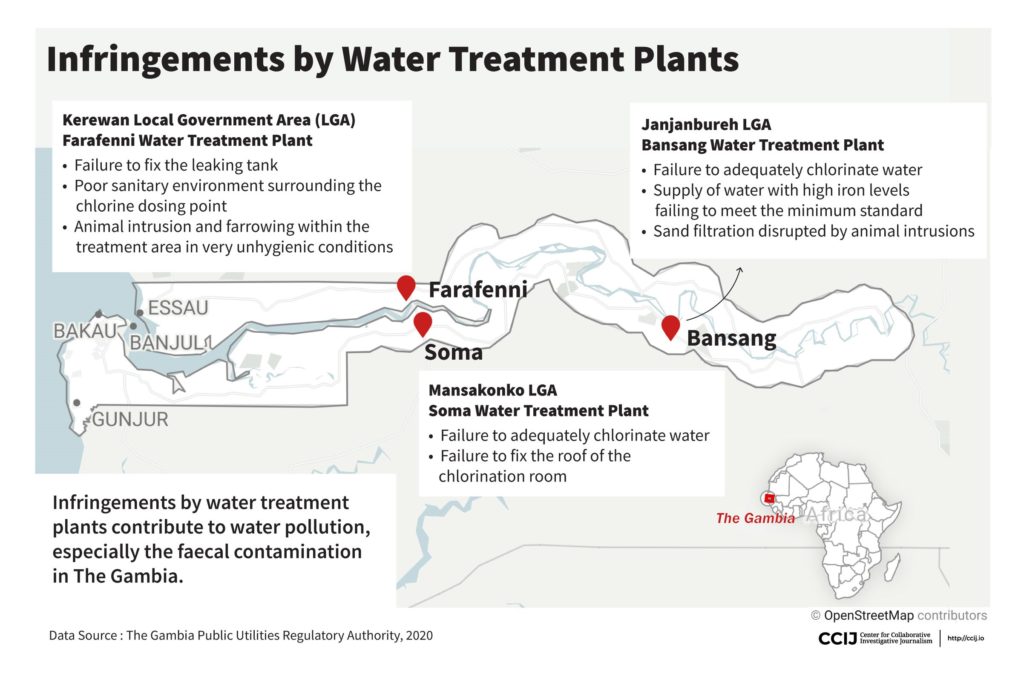
And Alex Tabbal, yet another local, posted: “I don’t have water in Kotu South for well over four months. The bill keeps coming every month. I spend (sic) over 500 dalasis (almost $10) on bottled water a week for me and my family. It’s really not fair”.
Homecoming nightmare
The situation isn’t just, as Tabbal puts it, “not fair” — it’s also dangerous.
Ida Faye knows this all too well. She cut short her three-week vacation to her native country after spending more than 12 years living in Rome, Italy, where she moved after completing high school.
Now in her early 30s, she was excited about this homecoming.
“I had missed The Gambia so much; I missed my family, my friends. I just felt I needed to go… because I was feeling so nostalgic,” she said.

On 16 January 2020, she landed at Banjul International Airport, The Gambia’s sole airport. After one day in Bijilo, a sprawling neighbourhood in the tourist area of Senegambia, she crossed the River Gambia to her native village of Essau in the North Bank Region.
But her elation at being home didn’t last long.
“After three days, I started to feel a stomach ache. I realised anytime that I drank, my stomach would start making noises. Then it began to turn as if my lungs were being pulled apart and I began to visit the toilet so often,” Faye recalled in a WhatsApp interview from her residence in Rome.
She eventually went to the main public hospital in Essau and later continued to Africmed, one of the most advanced private clinics in The Gambia.
“My… stomach ache was still going and coming. Sometimes it pained [me] so much that I thought it was my menstruation coming, but I knew my cycle was not due,” she said.
On her seventh day in The Gambia, Faye bought a return ticket to Italy. It was at a health centre in Rome that she was told her stomach cramps and diarrhoea were “likely caused by drinking unclean water in Africa”.
Her story is not unique.
More than 72,500 cases of diarrhoea were registered in The Gambia in 2019, according to the national Health Service Statistics, the latest year for which the report is available. Despite the fact that the incidence of fatal diarrhoea-related death has decreased by 25% since 2009, it still remains the eighth cause of death in The Gambia, according to the Institute for Health Metrics and Evaluation (IHME), an independent global health research center at the University of Washington.
And even though the national Health Service Statistics does not provide a record of diarrhoeal related deaths, Modou Njai, Director of Health Promotion and Education Directorate under the Ministry of Health, said diarrhoea is one of the leading causes of death in children under five years in The Gambia.
While both the national Health Service Statistics and Njai stopped short of indicating what was responsible for these deadly incidences of diarrhoea, the WHO says E. coli is one of the two most common causes of moderate to severe diarrhoea in low-income countries.
Poor service delivery
Faye’s native village, Essau, is similar to other rural settlements, though it is growing faster than most: barely half of the community receives NAWEC-supplied water in their households. And even for those that have access, it is not uncommon to go for days and weeks without a single water droplet.
“The failure of NAWEC to live up to its expectation has led to an increasing number of families resorting to their own sources of water for drinking and other household chores,” said Ousman A. Marong, Manager of Essau-based Nuimi FM, one of the few private radio stations in rural Gambia.
“Families that are at least better off dig boreholes in their compounds while others resort to shallow wells,” Marong said.
In conducting MICS, water samples were collected from both NAWEC taps and privately dug boreholes and wells. 31.7% of the population relying on piped water experienced E. coli contamination, while 69.7% of those using boreholes and wells were at risk of using contaminated water supplies.
And by the time water is drawn from the source, transported and stored in households for drinking, the contamination spreads wider. Faecal contamination is the main source of the bacteria in the water, according to the report.
Other experts confirm this. “E. coli in drinking water simply means there is an interaction between human and animal faeces with the water system, or simply put, when faeces from human and some animals get into the water, the water gets contaminated with E. coli,” said Peter Wampler, Professor of Geology/Hydrology at Grand Valley State University in the United States.
Ahmed Manjang, a Gambian microbiologist who has raised the alarm about water contamination in his native community, explained that the diarrhoea caused by E. coli can be fatal. Contaminated water causes abdominal cramps, fever, and vomiting. It can also cause kidney failure, pneumonia, anaemia, seizure and stroke.
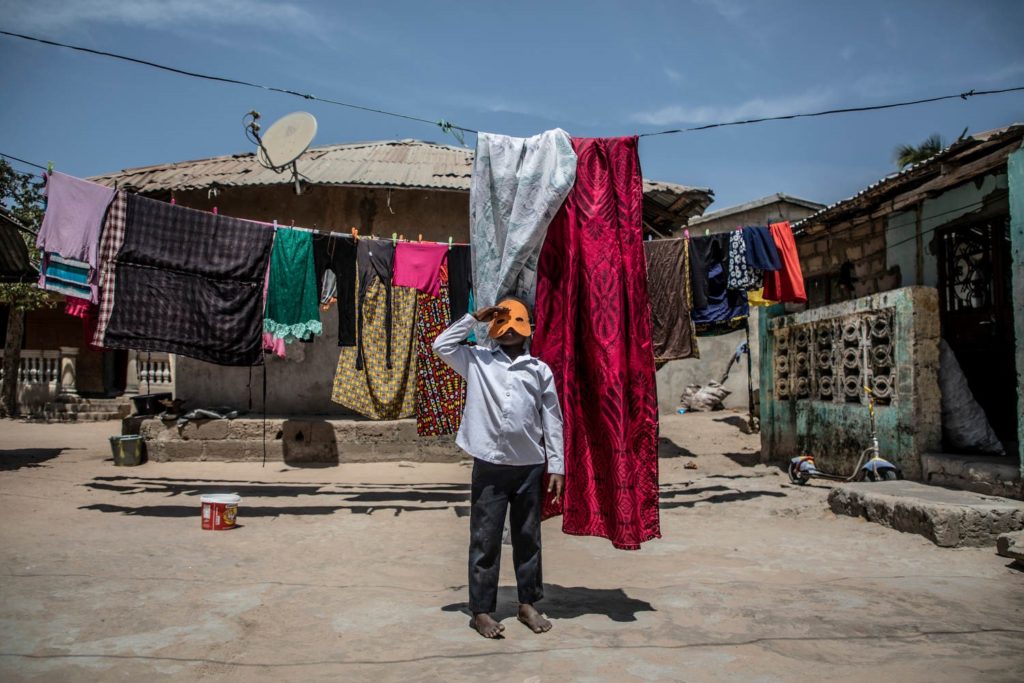
Nitrate also present
- coli contamination disproportionately affects the rural areas where more than 92% of households have E. coli in drinking water, according to MICS, compared to 63.5% in the urban centres.
Badou Saine, a biologist and environmental scientist, said the widespread contamination of E. coli in the rural areas was mainly due to people drawing water from unprotected wells.
Urban centres with pipe-bourne water supply by NAWEC also have another contamination: nitrate. It is colourless, odourless and tasteless — and can only be detected in drinking water through laboratory testing.
Nitrate is naturally found in underground and surface water, and it is one of the chemicals that The Gambia’s sole water quality laboratory under the Department of Water Resources looks out for in testing water samples. NAWEC does not have its own testing facilities.
For the last six years, two communities, Bakau and Old Jeshwang, with a total combined populationof about 75,000 inhabitants, have been found to have higher-than-safe-to-consume nitrate levels.
Saine, who is the senior lab technician at the water quality laboratory in Abuko, said based on the international standards The Gambia has adopted, drinking water should not have a nitrate level of more than 10 milligrams per litre.
“The result of the water testing in both Bakau and Old Jeshwang has been fluctuating between 12 to 18, and sometimes even 20+ milligrams per liter,” Saine said. “It has been fluctuating within this range for the past six years”.
Drinking water with nitrate of more than 10mg/l is dangerous to health, especially for infants and pregnant women. It causes blue baby syndrome in infants, which can lead to brain damage and even death.
The presence of nitrate may be an indicator of other contaminants in water supply, including pesticides which can be more harmful than nitrate, according to Pennsylvania State University researchers.
Nitrate reaches groundwater through various processes, including through excessive application of inorganic fertilizers, manures, and human and animal excreta, including septic tanks, the WHO says.
Nitrates also enter the water supply through burst sewage systems and water distribution pipes. They have to be removed from water using various treatment processes, including distillation. Heating or boiling water, as well as chlorination, are not enough.
Burst pipes make it worse
In Bakau and Old Jeshwang, like many other communities in urban Gambia, burst NAWEC water pipes that constantly flood streets are a common sight.
“This pipe has been like this for more than six months,” said Mabinta Gassama, a woman in her early 30s, pointing at a PVC pipe that was completely exposed from the ground. The pipe Gassama was referring to carries NAWEC-supplied water to compounds around her flooded area in Jeshwang.
On the same street, perhaps 250 metres away, water was bubbling up into the street from another burst pipe.
“This one burst I think last month,” said Juldeh Bah, a young man working from a general provision shop decorated in Coca-Cola’s colours not far from the burst pipe.
“Burst pipes in moments of service interruption or low water pressure from the tanks potentially serve as entry of contaminants in water,” biologist Saine said. “This is one of the ways that faeces and chemicals get into household drinking water”.
Of all the complaints PURA received on the sectors it regulates, 67% of them were about burst pipes, according to its 2015 annual report.
The regulator is aware of both the burst pipes and the nitrate problem.
“We are very concerned with the high level of nitrate,” said Musa Njie, Senior Water Manager at PURA. One of PURA’s mandates is to regulate the provision of water by NAWEC by monitoring the quality, accessibility and affordability of water across the country.
Njie said the regulator had brought the issue of nitrate to NAWEC’s attention and steps were being taken to remedy the situation. But six years after first being detected, the nitrate-contaminated water is still flowing.

Crimson coloured water
Elsewhere still, nitrates aren’t the problem — instead, residents’ taps run crimson because of iron contamination. The situation in Gunjur, a small, rural coastal town in the southwest, started five years ago, about a year after NAWEC began to supply water to this coastal community of about 15,000 inhabitants.
It took the trained eyes of microbiologist Ahmed Manjang to realise the changing water colour in his native village was not normal.
“I first noticed the poor quality of water in 2015, and I reported it to the NAWEC office through a telephone conversation, but I was told it was the water tank that was corroding,” Manjang said. He now lives in Saudi Arabia, where he works as a senior medical technologist at King Fahad Medical City in Riyadh.
Five years later, when he visited the village again while on vacation, he saw that the water was still the same colour.
“This time I collected the sample of water and took it to PURA to report the matter. After three days, they got back to me to say the problem was iron corrosion into the water”.
The high iron contamination of NAWEC-supplied pipe affects the taste of Gunjur’s water, and many residents prefer to get their water from a borehole that isn’t linked to NAWEC’s pipelines.
Gunjur resident Isatou Bojang said everyone living in her compound had stopped drinking water from NAWEC taps “for so long now”.
“We now go to the borehole at the nursery school to fetch water. The tank there is not linked to NAWEC water so the taste of that water is good,” Bojang said. “Even on days that the colour of NAWEC tap water is clear, the taste is still bad”.
And Modou Touray, a landlord, said the tap in his compound mostly supplies red-coloured water. “The kind of water that you get when you dig a new borehole and get water for the first time,” he said. “So I bought 15 empty 5-litre gallons that my children use to fetch water at the nursery school”.
The borehole at the nursery school that Bojang and Touray were referring to was privately dug. Many institutions and individuals now resort to private boreholes which are usually not fitted with water treatment facilities. Untreated water may contain bacteria, viruses and parasites which cause stomach cramps, pneumonia and other conditions.
A NAWEC staff member, who asked not to be named for fear of being disciplined for speaking to a journalist, confirmed that the company knew about Gunjur’s water problem.
In a recent US$43 million grant request to the World Bank, NAWEC said the boreholes and water tanks that it uses were built of steel in the 1960s and have deteriorated greatly over time, leading to corrosion and leakage of toxins into drinking water. In the grant request, the company admitted that it “does not have some essential tools necessary for it to run its water business properly”.
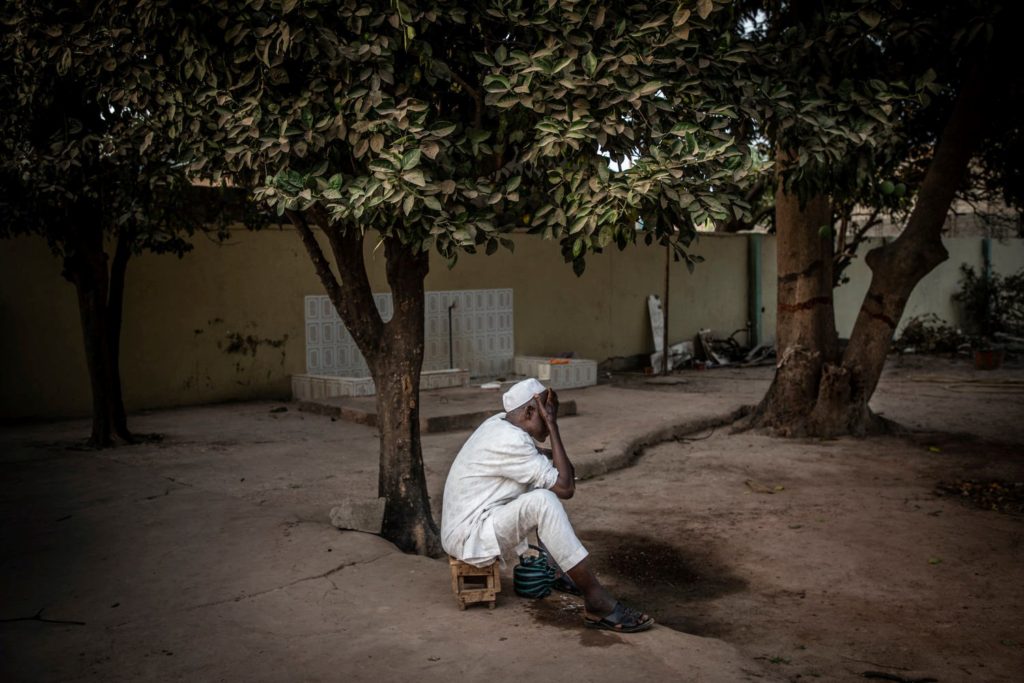
Does corruption play a part?
In early March this year, NAWEC confirmed the news reports of 15.5 million dalasis, about US$310,000, missing from its bank account at AGIB bank.
Without conducting an internal investigation, the company quickly dismissed the scandal as the bank’s problem without explaining how its stamp and the signature of its treasury manager and account director were used in the transaction.
Barely one month after the incident, police said they arrested at least 14 people and recovered about 10% of the funds stolen from the account. The police did not disclose whether any of those arrested were NAWEC employees.
NAWEC has been accused of being one of the most corrupt public institutions in The Gambia. Despite negligence in its service delivery and performance, no one has been prosecuted for corruption or negligence.
NAWEC declined a formal letter of request for an interview.
But in 2020, Alpha Robertson, the company’s then-managing director, publicly acknowledgedgrowing concerns about water quality, during a workshop on water safety planning.
“As far as NAWEC is concerned, the services that we provide should look at both quantity and quality. Everybody knows that in recent times there have been problems in the water supply; inadequate supplies in some cases for a long period of time”.
“In addition to that, there have been growing concerns in terms of the quality of water that we supply. The problem of water supply is mostly due to the negligence of the infrastructure and negligence of the capacity; both human as well as materials that have led to the situation where we are today”.
Until adequate steps are taken to address the problems that Robertson identified, it is the citizens of The Gambia who will likely pay the biggest price — their and their childrens’ health and safety.
Reporting: Lamin Jahateh
Photography: Jason Florio
Data analysis: Yuxi Wang and Hassel Fallas
Visualisations: Yuxi Wang
This report has been made possible by a grant from the African Investigative Journalism Conference, supported by Wits Journalism and Civicus and in collaboration with the Center for Collaborative Investigative Journalism (CCIJ).

